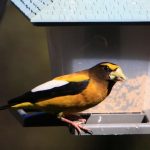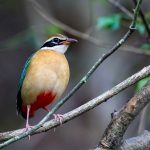The highlight of spring migration is without a doubt the return to northern climes of dazzlingly-colored warblers, flycatchers, and tanagers. These thrilling little critters aren’t waterfowl or raptors or waders. Instead, they are part of a club that can hardly be called exclusive. After all, about 5,400 species enjoy membership. These are what we in the birding biz call passerines.
A passerine is a bird in the order Passeriformes. This is easily the largest order of birds, comprising more than half of all known species. Passeriformes is divided into two suborders; most of these birds are Passerii, oscine songbirds. The rest are suboscines, distributed throughout Eurylaimi (broadbills), Tyranni, (flycatchers), and Menurae (lyrebirds). Oscines have greater control of their syrinx muscles than the suboscinces, which means they are usually better singers.
Passerines are all land birds and most are insectivorous. This latter fact explains why birders looking to rack up large numbers of passerines have to leave the backyard now and again. Most of these birds have no use for sunflower seeds and suet. It’s not hard to find them. In fact, the group is said to get its name from the Latin name for the Old World sparrow family Passeridae. Unless you live on the moon, you’ve probably seen one of these. The House Sparrow (Passer domesticus) is so common that it alone seems to make up half of all known birds.
Passerines you are likely to encounter in North America include Flycatchers, Shrikes, Vireos, Jays, Crows, Larks, Swallows, Chickadees, Titmice, Verdin, Bushtit, Nuthatches, Creeper, Wrens, Dipper, Bulbul, Kinglets, Gnatcatchers, Thrushes, Wrentit, Mockingbirds, Thrashers, Starling, Wagtails, Pipits, Waxwings, Phainopepla, Olive Warbler, Warblers, Tanagers, Towhees, Sparrows (Old World and New World), Grosbeaks, Buntings, Blackbirds, Orioles, and Finches. Some of these are the most beautiful birds you’ll find anywhere, so don’t let them pass you by.












Leave a Comment